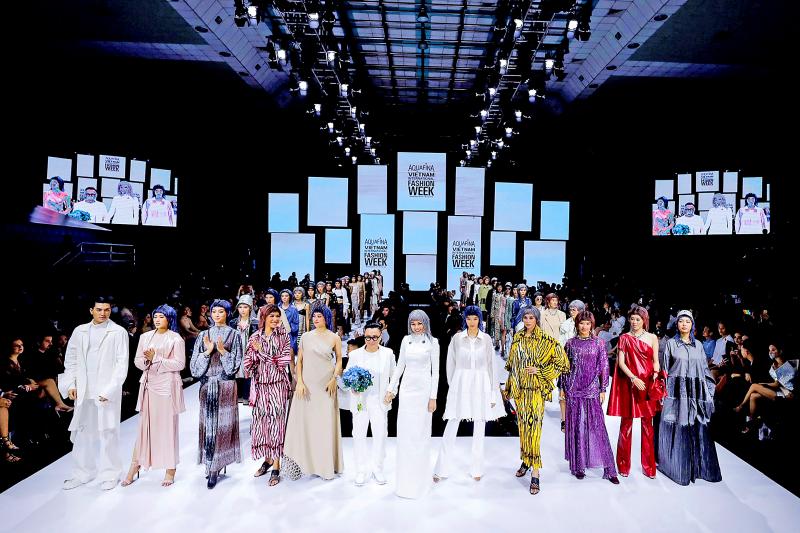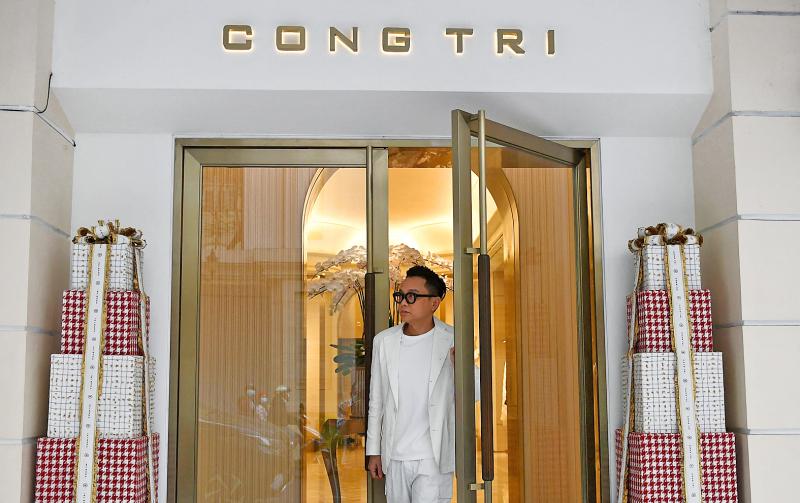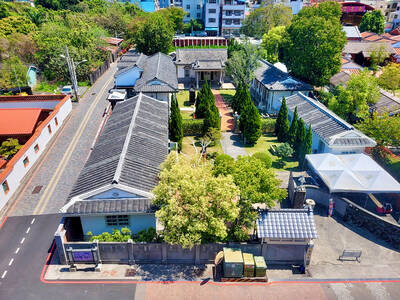When singer Rihanna posed for an ad campaign by luxury shoemaker Manolo Blahnik, she also made a star out of the little-known Vietnamese designer who made the oversized white shirt she posed in.
For more than two decades, Nguyen Cong Tri has been crafting chic structured eveningwear made of Vietnamese-spun silk, organza or taffeta, but despite some success at home, his designs had gained less traction elsewhere.
But when Rihanna showcased his Em Hoa range, inspired by the flower sellers of Vietnam, one famous name after another — Beyonce, Naomi Campbell, Gwen Stefani, Katy Perry, and Rita Ora among them — began picking out his designs to wear to high profile events.

Photo: AFP
“I am so proud. Designs by a Vietnamese designer, all Vietnamese production, being chosen and worn by Hollywood stars,” he said from his glamorous Cong Tri boutique in Ho Chi Minh City.
Some of his collections were dreamt up during flights over the rice fields of his homeland, another was influenced by the all-women militias of the Vietnam War.
With three stores in the country’s business capital, a judging role on the local version of reality TV show Project Runway, and growing international interest — he is a firm believer Vietnam has more to offer fashion beyond its role of factory workhorse.

Photo: AFP
Nguyen now has a staff of more than 150 people and is hopeful his success can guide a new generation of talent.
“It won’t be too far in the future that Vietnam can stake its claim on the world fashion map,” he said.
VIETNAM’S STRONG WOMEN
One of eight siblings, Nguyen was born in the central coastal city of Danang in 1978 — just three years after the war with the US ended. He studied industrial arts and initially took a job sketching out CD covers for Vietnamese musicians.
But a fascination with the “resilience and strength” of Vietnam’s women soldiers, who he had heard stories about at school, propelled his slide into fashion and led to his first collection — “Green Leaves,” made using a patchwork cloth technique that took inspiration from the winter uniform and hard green hats of the fighters.
“When they were at home, they worked in the rice fields, taking care of their families,” he said of the soldiers. “When on the battlefields, they became the militias: they were such strong women.”
“In all of my collections ... the characteristics that make a strong Vietnamese woman are always conveyed or hidden in my design, even in the material,” Nguyen added, dressed head to toe in white plus a pair of thick-rimmed black glasses.
At Tokyo Fashion Week in 2016, Tri showed off a collection made from Lanh My A silk, a highly durable material made in just one village in the Mekong Delta that requires huge skill and patience to produce. The fabric needs to be dyed up to 100 times using the ebony-colored mac nua fruit to achieve its leather-like appearance, and it took Nguyen two years to get together enough material.
Those designs were influenced by the ao ba ba — a traditional outfit worn by rice farmers — and his determination to bring his homeland into his clothes has won him fans far beyond Vietnam. His flower girl collection was spotted by Rihanna’s stylist at Tokyo Fashion Week — who promptly ordered three designs — and two years later, he became the first designer based in Vietnam with a show at New York Fashion Week.
FACTORY TO FASHION WEEK
However, Nguyen spent many years “trying and wishing” to get the attention of global stars in an industry where, according to a recent report by the Council of Fashion Designers of America, half of employees of color believe a fashion career is not equally accessible to all.
While the nation’s textile factories have hit the headlines this year over struggles to fulfill orders for global clothing giants such as Nike and Gap amid a brutal COVID-19 wave, a clutch of young talented designers alongside Nguyen are ready to reclaim the Made in Vietnam label. Tran Hung, also based in Ho Chi Minh City, has shown off his designs at London Fashion Week, while rising star Tran Phuong My made her New York Fashion Week debut in 2019.
“Making our names in the world fashion industry is the result of a long process of hard work,” said Nguyen, who previously joked that the secret to finding success abroad is to put in 18 hours a day at the office. Some say the pandemic has given the industry a chance to shift, with virtual catwalks allowing designers from all corners of the world to shine, but Nguyen believes Asian designers need to keep fighting to make it to the top.
He explains: “We have to always think of some way, some path to go down step by step. It’s not just about waiting for society to take a chance on us.”

April 28 to May 4 During the Japanese colonial era, a city’s “first” high school typically served Japanese students, while Taiwanese attended the “second” high school. Only in Taichung was this reversed. That’s because when Taichung First High School opened its doors on May 1, 1915 to serve Taiwanese students who were previously barred from secondary education, it was the only high school in town. Former principal Hideo Azukisawa threatened to quit when the government in 1922 attempted to transfer the “first” designation to a new local high school for Japanese students, leading to this unusual situation. Prior to the Taichung First

Chinese Nationalist Party (KMT) Chairman Eric Chu (朱立倫) hatched a bold plan to charge forward and seize the initiative when he held a protest in front of the Taipei City Prosecutors’ Office. Though risky, because illegal, its success would help tackle at least six problems facing both himself and the KMT. What he did not see coming was Taipei Mayor Chiang Wan-an (將萬安) tripping him up out of the gate. In spite of Chu being the most consequential and successful KMT chairman since the early 2010s — arguably saving the party from financial ruin and restoring its electoral viability —

The Ministry of Education last month proposed a nationwide ban on mobile devices in schools, aiming to curb concerns over student phone addiction. Under the revised regulation, which will take effect in August, teachers and schools will be required to collect mobile devices — including phones, laptops and wearables devices — for safekeeping during school hours, unless they are being used for educational purposes. For Chang Fong-ching (張鳳琴), the ban will have a positive impact. “It’s a good move,” says the professor in the department of

Toward the outside edge of Taichung City, in Wufeng District (霧峰去), sits a sprawling collection of single-story buildings with tiled roofs belonging to the Wufeng Lin (霧峰林家) family, who rose to prominence through success in military, commercial, and artistic endeavors in the 19th century. Most of these buildings have brick walls and tiled roofs in the traditional reddish-brown color, but in the middle is one incongruous property with bright white walls and a black tiled roof: Yipu Garden (頤圃). Purists may scoff at the Japanese-style exterior and its radical departure from the Fujianese architectural style of the surrounding buildings. However, the property